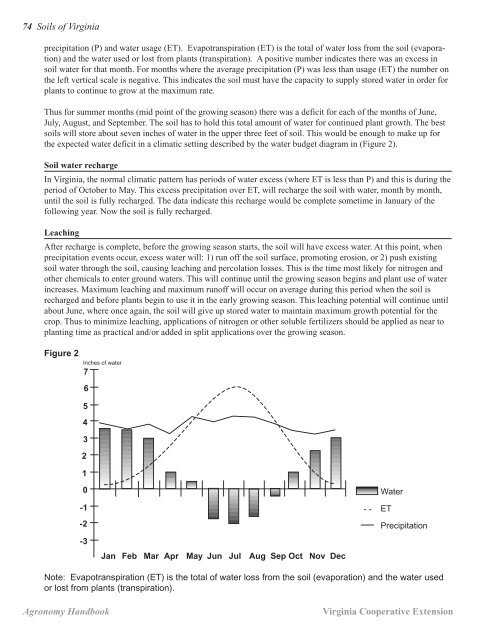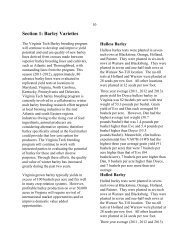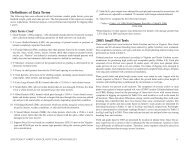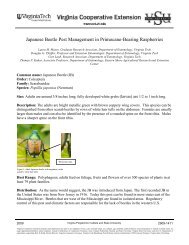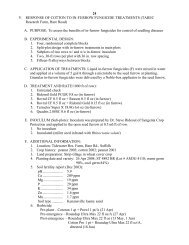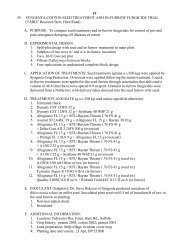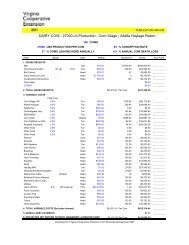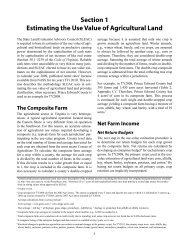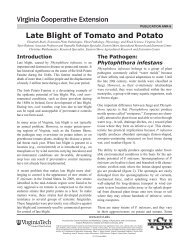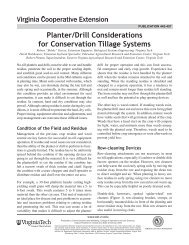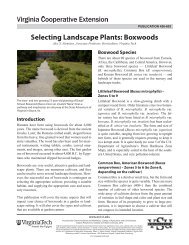PM Part VI-Soils of Virginia - Virginia Cooperative Extension ...
PM Part VI-Soils of Virginia - Virginia Cooperative Extension ...
PM Part VI-Soils of Virginia - Virginia Cooperative Extension ...
Create successful ePaper yourself
Turn your PDF publications into a flip-book with our unique Google optimized e-Paper software.
74 <strong>Soils</strong> <strong>of</strong> <strong>Virginia</strong><br />
precipitation (P) and water usage (ET). Evapotranspiration (ET) is the total <strong>of</strong> water loss from the soil (evaporation)<br />
and the water used or lost from plants (transpiration). A positive number indicates there was an excess in<br />
soil water for that month. For months where the average precipitation (P) was less than usage (ET) the number on<br />
the left vertical scale is negative. This indicates the soil must have the capacity to supply stored water in order for<br />
plants to continue to grow at the maximum rate.<br />
Thus for summer months (mid point <strong>of</strong> the growing season) there was a deficit for each <strong>of</strong> the months <strong>of</strong> June,<br />
July, August, and September. The soil has to hold this total amount <strong>of</strong> water for continued plant growth. The best<br />
soils will store about seven inches <strong>of</strong> water in the upper three feet <strong>of</strong> soil. This would be enough to make up for<br />
the expected water deficit in a climatic setting described by the water budget diagram in (Figure 2).<br />
Soil water recharge<br />
In <strong>Virginia</strong>, the normal climatic pattern has periods <strong>of</strong> water excess (where ET is less than P) and this is during the<br />
period <strong>of</strong> October to May. This excess precipitation over ET, will recharge the soil with water, month by month,<br />
until the soil is fully recharged. The data indicate this recharge would be complete sometime in January <strong>of</strong> the<br />
following year. Now the soil is fully recharged.<br />
Leaching<br />
After recharge is complete, before the growing season starts, the soil will have excess water. At this point, when<br />
precipitation events occur, excess water will: 1) run <strong>of</strong>f the soil surface, promoting erosion, or 2) push existing<br />
soil water through the soil, causing leaching and percolation losses. This is the time most likely for nitrogen and<br />
other chemicals to enter ground waters. This will continue until the growing season begins and plant use <strong>of</strong> water<br />
increases. Maximum leaching and maximum run<strong>of</strong>f will occur on average during this period when the soil is<br />
recharged and before plants begin to use it in the early growing season. This leaching potential will continue until<br />
about June, where once again, the soil will give up stored water to maintain maximum growth potential for the<br />
crop. Thus to minimize leaching, applications <strong>of</strong> nitrogen or other soluble fertilizers should be applied as near to<br />
planting time as practical and/or added in split applications over the growing season.<br />
Figure 2<br />
Inches <strong>of</strong> water<br />
7<br />
6<br />
5<br />
4<br />
3<br />
2<br />
1<br />
0<br />
-1<br />
-2<br />
-3<br />
Jan Feb Mar Apr May Jun Jul Aug Sep Oct Nov Dec<br />
- -<br />
Water<br />
ET<br />
Precipitation<br />
Note: Evapotranspiration (ET) is the total <strong>of</strong> water loss from the soil (evaporation) and the water used<br />
or lost from plants (transpiration).<br />
Agronomy Handbook<br />
<strong>Virginia</strong> <strong>Cooperative</strong> <strong>Extension</strong>


